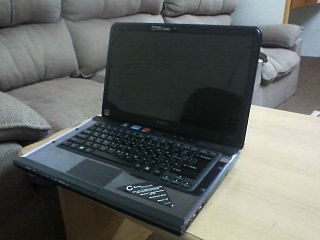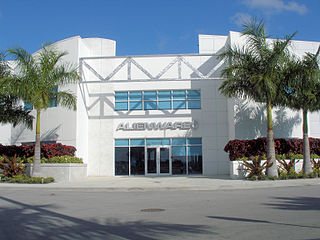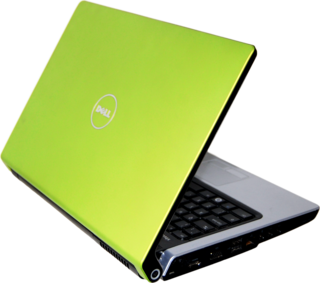The Sony Vaio SR series was a line of consumer-grade notebook computers from Sony introduced in July/August 2008 to replace the Sony Vaio C series range (they could also be seen as competing with the lower end SZ models), as a part of the Intel Centrino 2 launch. They are equipped with a 13.3" screen and weigh approximately 1.95kg, significantly lighter than the C series, similar to the non-premium carbon fiber models of the SZ, but significantly heavier than the Z Series (which, unlike the SR, uses carbon fiber to reduce weight).

Sony Corporation is a Japanese multinational conglomerate corporation headquartered in Kōnan, Minato, Tokyo. Its diversified business includes consumer and professional electronics, gaming, entertainment and financial services. The company owns the largest music entertainment business in the world, the largest video game console business and one of the largest video game publishing businesses, and is one of the leading manufacturers of electronic products for the consumer and professional markets, and a leading player in the film and television entertainment industry. Sony was ranked 97th on the 2018 Fortune Global 500 list.

The Sony Vaio C Series is a discontinued series of notebook computers from Sony introduced in September 2006 as the consumer alternative follow-up to the then current SZ series. Like the SZ, the C featured a 1280x800 13.3" LCD screen, plus Core 2 Duo CPUs. As a consumer laptop, a variety of colours were offered, while compared with the SZ, the C series was heavier, and lacked the switchable graphics option, instead offering either lower-power Intel GMA 950 or faster Nvidia GeForce 7400 graphics. A crocodile-skin option was offered in Japan.
As with the SZ and C series laptops, the SR uses a 16:10 ratio 1280x800 LED-backlit screen. All are configured with Intel Core 2 Duo CPUs and DDR2 RAM. SSD storage, instead of hard drive, is an option.
Base-line models feature integrated Intel 4500MHD graphics, while higher-end laptops are equipped with ATI Mobility Radeon HD 3470 graphics (in later models the ATI Mobility Radeon HD 4570 is the discrete graphics option). Compared with the higher-end Z series, which has GeForce 9300M GS graphics (producing less heat in the smaller chassis of the Z series), the ATI-equipped SR offers better gaming performance, marking it out as the consumer/gamer's option. The SR also features a 1.3 megapixel webcam to the 0.3 megapixel found on the Z.
Options available on the Z series that were not available on the SR are WWAN (HSDPA), and RAID SSD. CPU, RAM and hard drive options are the same on both models, and, as with the Z, the SR features a Blu-ray drive option.
VAIO Corporation , which is headquartered in Azumino, Nagano in Japan, is a manufacturer that makes personal computers and smartphones. VAIO was originally a brand of Sony, introduced in 1996. Sony sold its PC business to the investment firm Japan Industrial Partners in February 2014 as part of a restructuring effort to focus on mobile devices. Sony maintains a minority stake in the new, independent company, which currently sells computers in the United States, Japan, and Brazil as well as an exclusive marketing agreement.
Sony still holds the copyright trademarks for the VAIO brand and logo. Currently in the US, VAIO products are sold by Trans Cosmos America, Inc.

Alienware is an American computer hardware subsidiary of Dell. Their products are designed for gaming and can be identified by their alien-themed designs. Alienware was founded in 1996 by Nelson Gonzalez and Alex Aguila.
The company's corporate headquarters is located in The Hammocks, in Miami, Florida.
Dell XPS is a line of high performance computers manufactured by Dell.
The SZ is a discontinued series of notebook computers from Sony introduced in mid-2006 to replace the S series. They fall into the ultraportable notebook class, with a 13.3" 16:10 ratio 1280x800 screen, and a weight from 1.69kg for the top model, which featured carbon fiber casing. The first models came with an Intel Core Duo Processor; in later models, this was replaced with an Intel Core 2 Duo.
The MacBook Air is a line of laptop computers developed and manufactured by Apple Inc. It consists of a full-size keyboard, a machined aluminum case, and a thin light structure. The Air is available with a screen size of 13.3-inch (33.782 cm), with different specifications produced by Apple. Since 2010, all MacBook Air models have used solid-state drive storage and Intel Core i5 or i7 CPUs. A MacBook Air with an 11.6-inch (29.46 cm) screen was made available in 2010 through late 2016.

Dell's Studio brand was a range of laptops and desktops targeted at the mainstream consumer market. The computers sit above Dell's Inspiron and below the XPS consumer lines in price and specifications. They differ from Dell's lower-end Inspiron models by offering slot-loading optical drives, media keys, more cover design options, faster processor options, HDMI and eSATA ports, LED-backlit screens and backlit keyboards.
The HP Pavilion dv7 was a model series of laptop/mobile Pavilion branded computers manufactured by Hewlett-Packard from 2008 that featured a 17.3" diagonal display. The HP Pavilion dv4 featured a 14.1" and the HP Pavilion dv5 a 15.4" display. The DV7 had bays for two hard drives, but was supplied with one; if a second hard drive was fitted then a hard drive hardware kit of bracket, connector cable, Mylar shield, and screws was required.

The Sony Vaio P series is a range of ultraportable subnotebook computers launched in January 2009.

Sony Vaio FW is a discontinued series of notebook computers which were the first laptops ever to have a 1080p 16.4" 16:9 widescreen LCD. Higher end models in the series can support an integral Blu-ray Disc reader or writer. The laptop weighed 3.1 kg. The battery lasts up to 2 hours. In June 2009, the ATI Mobility Radeon HD 3650 was replaced by the ATI Mobility Radeon HD 4650 with the release of the FW 4xx series. Additionally, Sony also released a special model of this series apart from the signature series models (Model:VGN-FW590FFD). This model had a futuristic themed cover and came equipped with moderately high-end specifications for $1069.99 U.S. dollars. The VGN-FW590FFD model was also only available for purchase through Sony Style's website.
Sony has used the Z model naming scheme for its high-end ultraportable notebook computers since 2000. Unlike other Sony models, the Z has always been manufactured in Japan or in the United States for some models. Sony has stated that production of the Z series will cease at the end of 2012.
The Vaio X series is a line of high-end ultraportable notebook computers from Sony introduced in September 2009, claiming to be the world's lightest notebook, at 655 grams ( ). It features an 11.1", 16:9, 1366x768 LED-lit LCD screen with built-in webcam, 2GB of DDR2 RAM, a choice of 64, 128 or 256 GB SSD, Intel Atom Z540 1.86 GHz or Z550 2.00 GHz, WWAN.
The Sony Vaio TT series was a line of high-end ultraportable notebook computers from Sony introduced in September 2008, with high-end features including an ultra-low voltage Core 2 Duo processor with DDR3 SDRAM; an 11.1", 16:9, 1366x768 LED-backlit LCD screen with built-in 0.3 megapixel webcam; choice of 1.8" hard drive or SSD ; and optional Blu-ray drive. The weight of the laptop is 1.3 kg.

The Vaio S series was a line of notebook computers from Sony introduced in summer 2004. They have been touted as business laptops, and their designs have focused on being thin and light. They also have features friendly to businesspeople, such as TPM chips, matte (anti-glare) displays, RAID SSDs, and extended sheet batteries, as well as continuing to include RJ-45 and VGA (D-Sub) connections.
The Sony Vaio 505 series was a line of ultraportable notebook computers from Sony's VAIO brand. The introduction date in the United States was July 24, 1998.
The Vaio AW series is a discontinued range of high-end multimedia laptop computers from Sony introduced in September 2008, replacing the AR Series. They feature an 18.4" 16:9 screen with 1680x945 or LED-backlit 1920x1080 (1080p) screen, NVidia GeForce 9300M GS 256MB or 9600M GT 512MB graphics, Blu-ray drive, Intel 5100AGN wireless chipset, Core 2 Duo P or T CPUs and a 1.3 megapixel webcam, optional RAID SSD storage and HDMI output.
The Vaio Y series is a line of notebook computer from Sony introduced in January 2010. It is a netbook-inspired model designed for travel use: compared with the other 13.3" models in the Vaio range, the Y lacks an optical drive, and is heavier and cheaper than the premium Sony Vaio Z series, but lighter than the consumer-grade Sony Vaio S series, with better battery life than either, thanks to the use of CULV processors. The weight is 3.92lbs (1.78kg).
The Sony Vaio E series is a range of consumer-grade laptops manufactured by Sony since 2010. The 14 and 15" laptops are configurable in a choice of bright colors: Passion Purple, Iridescent Blue, Caribbean Green, Coconut White, Hibiscus Pink, Lava Black and Gunmetal Black, while the 17" laptops offer only black or white. There is also an 11.6" version available. Each laptop each features up to 8GB DDR3 RAM, optical drive, Bluetooth functionality, 802.11b/g/n wireless and gigabit ethernet.

The ThinkPad X series is a line of notebook computers and convertible tablets originally produced by IBM and now marketed by Lenovo.
The Dell Inspiron series of laptop computers was introduced in 2000 as a consumer oriented line, available to the general public through electronics and department stores, contrasting to the business/enterprise-oriented Dell Latitude series of laptop computers, and are usually ordered from Dell directly via the website, phone, or mail-order.







